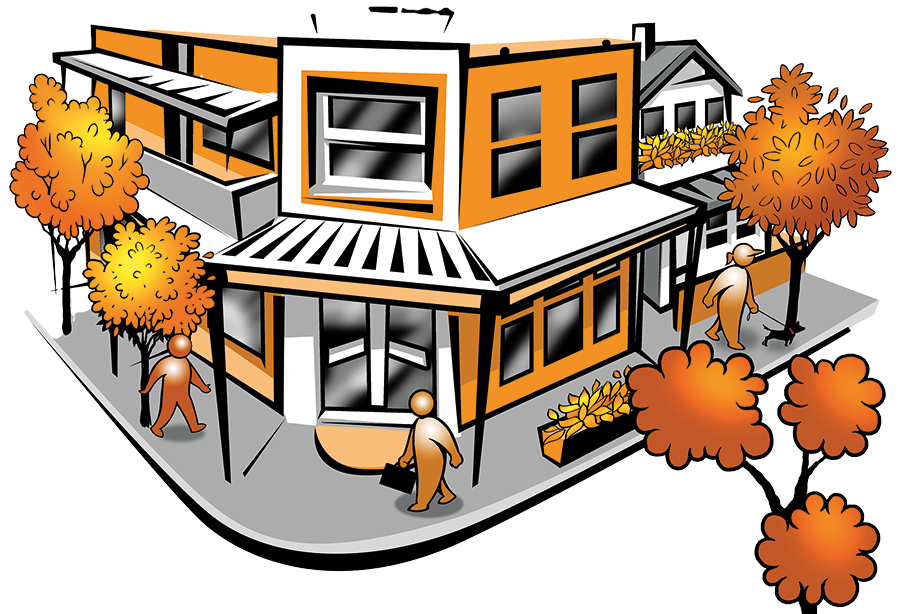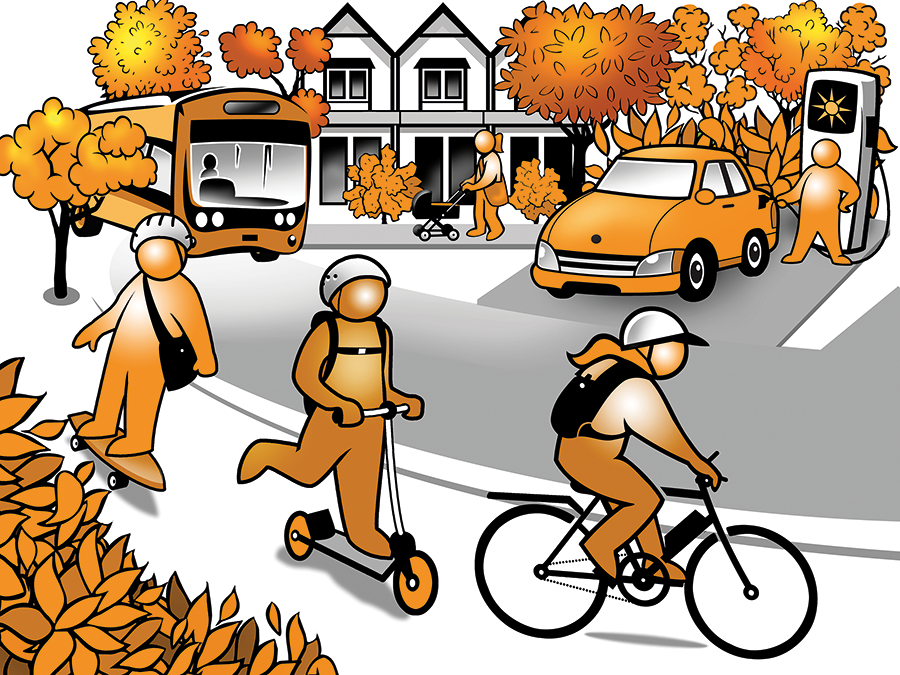#  Site Layout and
Site Layout and
Liveability
Subdivision design can improve functional site layout and liveability by focusing on connecting residents to local amenity.
# Why do subdivisions need to improve functional site layout and liveability?
Residential subdivision presents a significant opportunity to influence the urban structure of a neighbourhood - how residents are connected to local amenity, community infrastructure and a range of transport modes. There is a significant opportunity to set the pre-conditions for strong sustainability outcomes across several of the other categories including: Energy, Streets and Public Realm, Ecology, Integrated Water Management and Urban Heat. Most attention is usually directed to “hard” infrastructure, such as power, water, telecommunications and transportation.
 Local neighbourhood shops offer convenient amenities and promote walking to nearby destinations, helping to reduce reliance on cars.
Local neighbourhood shops offer convenient amenities and promote walking to nearby destinations, helping to reduce reliance on cars.
# Benefits of improved site layout and liveability
Developers can take advantage of:
- Enhanced market appeal to prospective purchasers
- Expanded range of land purchasers
- Demonstration of best practice social infrastructure consideration
A new resident can expect:
- Better connection to local amenity and services
- Improved health and wellbeing due to better connection to local amenity
- Ability to age-in-place with access to various housing typologies to accommodate changing requirements
- Efficient connections within the subdivision and to other destinations
“ When seeking to improve the functional site layout and liveability of subdivision design, it is important to consider how residents will be connected within and beyond the boundaries of subdivision, while considering how the subdivision design responds to the existing site conditions. ”
# Connectivity
Connectivity considers how future residents will move within the boundaries of the subdivisions as well as their connection to transport networks and surrounding local amenity. Connectivity principles include:
- Contributing to land use and transport integration
- Creating compact neighbourhoods that are oriented around easy walking distances to activity centres, schools and community facilities, public open space and public transport
- Maximising permeability of the street network and aligning roads to the four compass points
- Aligning active transport routes, waterways and open space corridors where possible
- Ensuring that wayfinding is logical and meets the needs of all
Having convenient access to local amenity for future residents can have an impact on their health and wellbeing, while delivering community infrastructure early provides an opportunity to improve future resident experience.
# Adaptability
Subdivision design should take into consideration the local context including the topography of the site and existing natural features as well as providing opportunities to respond to the changing requirements of future residents. Adaptability principles include:
- Considering topography in site design including lot layout, orientation and size, length of street blocks, any existing natural and man-made features
- Retaining natural features (e.g. canopy vegetation) for incorporation into public open space and streetscapes
- Providing for a diversity of lot sizes to support all household types
Integrating and retaining natural features creates the additional benefits of maintaining biodiversity and also ensures that established vegetation is a key feature in the neighbourhood. Diversity of lot sizes supports opportunities for a range of income groups, while improving housing choice and enabling aging in place.
# Alternative transport
Functional site layout and liveability can drive reductions in transport related emissions by providing residents with access to alternatives to the private vehicle, ultimately reducing car dependence. Alternative transport principles include:
- Improving transport efficiency
- Reducing air pollution from transport related emissions
- Reducing car dependence
- Providing a commuter and recreational bicycle network
- Providing for transition to new transport modes (electric vehicles, electric scooters etc.)
Reducing transport related emissions is not only a result of providing access to alternatives, there is also a strong link to connectivity. Where neighbourhoods are compact, residents are less likely to rely on cars and more likely to use alternative transport options.
 Compact and liveable neighbourhoods with diverse transport options help reduce car dependence and transport emissions.
Compact and liveable neighbourhoods with diverse transport options help reduce car dependence and transport emissions.
# Case study
| Location | Ecco Ripley, City of Ipswich (opens new window) |
| Site Area | 194 ha |
| Number of Dwellings | 4,000 |
| Development Type | Residential + community infrastructure |
| Year / Status | 2014 (launch) / Ongoing |
| Sustainability Accreditation | 5-star Green Star - Communities |
| Key Stakeholders | Sekisui House (Development) |
| Key Features | - Bikeways and walking paths which aim to link residents to green spaces, communal spaces and the town centre. - A transit hub which will connect the community to other city centres via proposed buses and trains. - A compact town centre increasing access to facilities and services. - Over 20 per cent of the site to be dedicated to green open space allowing all homes to be located no more than 400m away. |
DISCLAIMER: This Fact Sheet has been created for general information purposes only. While the Fact Sheet has been created with all due care, no warranty is given as to its suitability for any particular purpose and users should obtain their own advice relevant to their situation and specific needs. MAV or any party authorised by MAV to reproduce the Fact Sheet is not responsible for the accuracy, currency or reliability of the Fact Sheet and accepts no liability for any damage, losses whether direct or indirect, claims or expenses howsoever arising from any party who may rely on its contents.
The Council Alliance of a Sustainable Built Environment (CASBE) maintains these Sustainable Design fact sheets on behalf of our member councils. (opens new window)
CASBE is supported by the Municipal Association of Victoria (MAV).
Copyright © Municipal Association of Victoria 2025